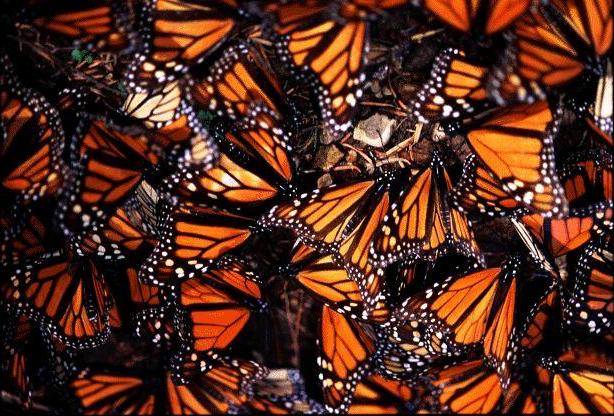

MONARCH BUTTERFLIES
Dee Finney's blog
start date July 20, 2011
Today's date May 22, 2012
page 222
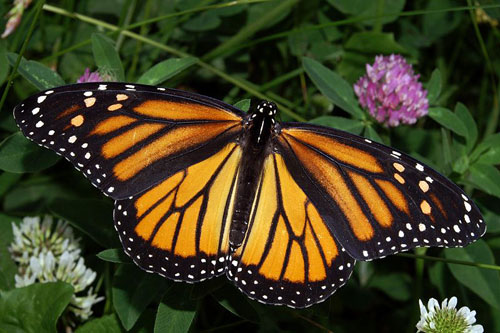
TOPIC: WHERE ARE ALL THE MONARCH BUTTERFLIES?
NOTE FROM DEE THIS PAGE CAME ABOUT BECAUSE OF A DREAM AND THE OVERWHELMING FEELING THAT I'VE KNOWN BARBARA MEITNER FOREVER.
THE MEDITATION WAS TO CONNECT WITH MY HIGHER SELF::
5-22-12 - MEDITATION DREAM - I was on a city street and stopped
in at a restaurant. It was crowded at first, but emptied out almost
instantly when Aa man came in with a large German Shepherd dog.
The man I was sitting next to at a table was not very nice and I left immediately after not even waiting for my ice cream cone to arrive.
For some reason, instead of just waking, I was dragging a rolling office chair and that helped me rest for a minute here and there because the route I chose had a lot of ankle deep water to traverse alongside the road, which looked rather like Oklahoma Ave. in Milwaukee, WI.
Along the way, a bright red car, driven by someone name Said ______ and his
wife came by and said they were going to choir practice and they pulled into a
home church driveway.
A little further along, I came to a house where I was called by name,
Dolores, and the man said he was Mr. Meitner, and I asked if Barbara was
home and he said, "yes" and called her out.
She had been playing music, so I heard music during our whole conversation,
and while I was talking to her, one of her neighbor's came out whom I also
knew by the name of Patty.
Patty came over and we talked for just a minute and I introduced the two women. Patty then said to Barbara, "You are known by the type of music you play."
Patty's sister then came along, and she and Patty were dressed identical and had identical noses with a prominent bump on them. I asked her what her name was, and she said, "Patty".
I laughed and said, "Well. That's appropriate."
At that point, Barbara was about to invite us into her home to listen to some more music, which Patty said identified her.
and I woke up.
After I woke up, I felt like I had known Patty and Barbara for many years.
Do I?
AFTER I WOKE UP, I IMMEDIATELY WENT TO MY COMPUTER TO LOOK UP BARBARA MEITNER. SHE AND I DIDN'T LIVE IN THE SAME CITY OR STATE, NOR EVEN IN THE SAME GENERATION, SO WHY DO I FEEL THIS OVERWHELMING FEELING OF KNOWING HER? THEN I SAW SHE WROTE ABOUT SOMETHING I'VE ALWAYS HAD AN INTENSE LOVE FOR - MONARCH BUTTERFLIES. THUS CAME THIS PAGE.
WHENN I LIVED IN WISCONSIN, I ALWAYS LOOKED FOR THE MONARCHS EVERY YEAR, AND IN 1993, I FOUND A DEAD MONARCH BUTTERFLY LYING ON A SIDEWALK. I PICKED IT UP GENTLY AND TOOK IT HOME WITH ME. FOR A TIME I LOOKED AT IT NOW AND THEN LYING ON MY DRESSER AND I KNEW IT WOULD GET DUSTY SO I PUT IT IN MY JEWELRY BOX DRAWER SAFELY.
IT IS NOW 2012 AND I STILLL HAVE THAT SAME MONARCH BUTTERFLY IN ITS SAFE PLACE IN MY JEWELRY BOX, I HAVE HUGE BUTTERFLY BUSHES GROWING IN MY YARD IN CALIFORNIA, AND I STILL ALWAYS LOOK FOR THE MONARCHS EVER YEAR BECAUSE WE ARE ON THE NORTH-SOUTH FLY ZONE AS THEY MIGRATE.
“Where are the monarchs?” has been a common question asked of us over the last month or so and the following is the best answer I can provide at this time.
Thanks to all of you who have contacted us with your assessments of the status of the monarch population. The vast majority of reports indicate that the monarch population appears to be much lower than normal. Most of these observations have been from areas where the monarchs are between broods and sightings of adults are usually low in early and mid July. So, this aspect of the reports is not alarming. The general absence (or low numbers) of larvae, as indicated in many reports, is of greater concern. The larvae present now mature into adults in late July and early August. These butterflies produce the offspring (from eggs generally laid from the 20th of July to the 10th of August) that become the butterflies that join the fall migration. Again, with few exceptions, unless you are all missing something out there, the number of reproducing adults over the next three weeks will be low, to be followed by a relatively small migratory generation. This assessment could be wrong of course and let’s hope that this is the case.
Assuming our collective assessments are, in fact, correct and that the population is low, how do we account for the lower than expected number of monarchs?
Here is what I know about the monarch population (December 2007 to the present):
1. The overwintering population in Mexico measured 4.61 hectares, a bit lower than the average of about 6 hectares in recent years, but not alarmingly so.
2. Although mortality during the winter was higher than normal at one location on Cerro Pelon, overwintering mortality appeared to be normal at other locations.
3. Examination of monarchs at several colonies at the end of the season showed them to be in remarkable condition with large numbers of nearly immaculate butterflies with large fat bodies. The proportion of monarchs in poor condition appeared to be lower than normal.
4. The migration into Texas appeared to be quite good, although a bit delayed. Some monarchs lingered at the overwintering sites as late as the first week of April. Various observers in Texas reported large numbers of returning adults and others subsequently reported large numbers of larvae on milkweeds in pastures south of Dallas.
5. March temperatures in Texas were neither too hot nor too cold and the simple temperature based model I’m developing suggested at that time that the overwintering population might be as high as 8 hectares. All appeared to be well in Texas and on track to produce a large number of first generation monarchs that could colonize the northern breeding grounds.
6. The first generation monarchs usually pass through Kansas from the last few days of April through the first week of June. During good years, the movement of first generation monarchs through this area can be quite conspicuous with many of the passing monarchs stopping to lay eggs on the blooming milkweeds. There was no obvious “flow” of first generation monarchs through the area this year and relatively few eggs and larvae were found on milkweeds in May and early June.
7. This observation gives rise to two questions: a) was the first generation much smaller than expected? and b) are there other explanations for the relatively low numbers of monarchs that reached the northern breeding grounds? Or, is the explanation some composite of these two possibilities?
8. At this point there is no way to assess the success of the first generation in Texas and other southern states. If the fire ant population was higher than it has been in recent years, predation by these ants could have had an impact. However, I don’t think the ants are widespread or abundant enough to have a large-scale impact on the population. The weather during March and early April in Texas was favorable for reproduction so I’m inclined to look to another cause.
9. May, the moving month for first generation monarchs, was cold – throughout the entire northern breeding range. It was also a period of frequent storms and heavy rains, particularly during the second half of May. Early June also saw heavy rains, especially in the east north central and central portions of the country.
10. In spite of these limiting conditions, bursts of monarchs reached some northern breeding areas, notably Iowa, parts of Ontario, and southern New England.
11. So, how could the May and early June conditions have limited the monarchs? In a few words, by: a) limiting dispersal, b) reducing egg laying, and c) increasing mortality of adults. All together such effects result in a reduction of the potential fecundity of the generation and the “realized fecundity” is lower than expected. The impact of lower temperatures and heavy rains on survival of larvae are unknown but might also have reduced the population.
12. What about the future? The monarchs could surprise us. If temperatures are moderate for the remainder of the summer and a substantial number of eggs are laid from 20 July to 10 August, the population could rebound.
13. As a number of you have pointed out, this year is not a good year for butterflies in general. This means that the parasites and predators that make a living feeding on a broad range of lepidopterous larvae are starving or not reproducing in good numbers. If parasites and predators are low, the result could be that there will be a reduction in the loss of monarch larvae during the last generation giving rise to a larger migratory population that seems to be indicated at this time.
Based on what we know now, my expectation is that the overwintering population in Mexico will be lower than the 4.61 hectares measured last year. As always, I hope my predictions are overly pessimistic.
CINNEBT FRIN BARBARA MEITNER
By Barbara Meitner on Sep 28, 2008
I live West of Panama City beach. about 1/4 of a mile from the beach. We have lived here six years and have alway had Monarchs. This is the first year we have not seen even one anywhere around here. We’ve only seen two honey bees, too. I have a lot of milkweed and flowering plants. Most for butterflies, bees and hummingbirds. We have a lot of hummers this year. I had to put out twelve feed for them. I’ve read that geneticly modified corn creates it’s own pesticide in the pollen and it’s widely broadcast by the wind. Could this be killing the butterflies and bees?
SEE THE LINK BELOW FOR OTHER COMMENTS:
http://monarchwatch.org/blog/2008/07/where-are-the-monarchs/
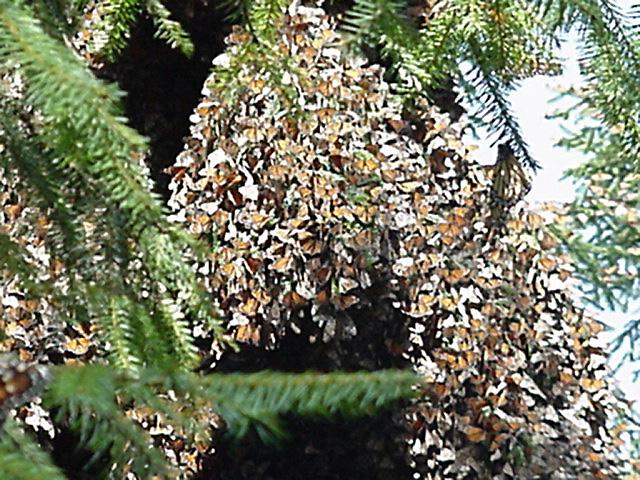
Monarch Butterfly Biosphere Reserve is a conservation area and World Heritage Site within the wintering grounds of most of the monarch butterflies that migrate from east of the Rocky Mountains for up to 4,000 km south to central Mexico. The reserve is located in the Trans-Mexican Volcanic Belt pine-oak forests ecoregion on the border of Michoacán and Mexico State, 100 km (62 milles), northwest of Mexico City. It is estimated that between 60 million and 1 billion butterflies arrive in this area alone any given year. While over 56,000 hectares are part of the biosphere reserve, the butterflies themselves only inhabit a fraction of this when they are in Mexico from October to March. The biosphere’s mission is not only to protect the butterfly species, but also to protect the ecosystem of which it is a part.
This area, which hosts the majority of wintering monarchs from the east of the United States and Canada, has only been known to scientists since the 1970s. Protection of the area began with a series of presidential decrees in the 1980s, and a 2000 decree promoted the area to the status of federal biosphere reserve. In 2008, the Reserve was inscribed on the list of World Heritage Sites. Although the montane site remains predominantly rural, a number of conservationists are concerned about the deleterious effects of illegal logging, growing tourism, and tensions between conservation authorities and communities inhabiting the land upon which the Reserve was established[1][2]
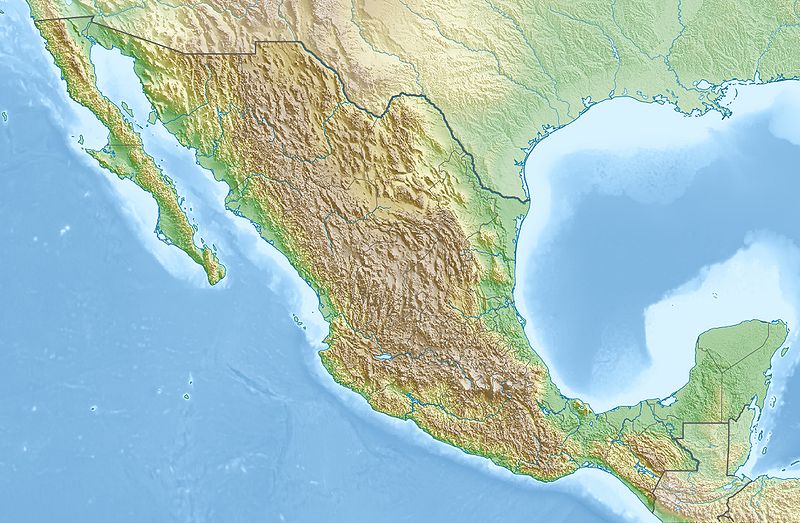
The monarch butterfly is noted for their lengthy annual migration. It is the only butterfly species known to make annual north-south migrations like many bird species do. Monarchs in North America roughly divided into two migrations. Those in the west tend to migrate toward California for the winter and those east of the Rocky Mountains migrate south. However, no single individual makes the entire round trip, as butterfly lifespans vary from just two months to about seven months for those who hibernate[3] It is not clear how these monarchs know how to return to the same wintering sites as their ancestors, but flight patterns seem to be inherited.[4][5]
Wintering sites for these eastern butterflies are thought to be as far north as Texas and Oklahoma .[6] However, most travel south into Mexico, crossing the border south from Texas and then following the Sierra Madre Oriental mountains.[7] After thirty years of studying the migrations of eastern monarchs, zoologist Freud Urquhart discovered in 1975 the site where the butterflies migrate to. They spend the winter in the forests of pine and oyamel fir in central Mexico, along the border of the states of Michoacán and Mexico. For those who come from the U.S./Canadian border area, this represents a voyage of about 4,000 km (2,485 milles).[8] This southward migration concentrates a large number of insects from a widely dispersed area in the north to a small area in the south. This kind of migration is unique in the world.[9][10] These butterflies spend about five months in this area of Mexico, arriving in October and leaving in March.[8]
It is estimated that anywhere from 60 million to a billion butterflies arrive to the central Mexican highlands every winter, mostly clustering in the small area along the border of the states of Michoacán and Mexico.[8][9] These butterflies congregate into colonies, clustering onto the pine and oyamel trees. In many cases, they are so thick that the trees turn orange in color and branches sag from the weight.[9][11] When these butterflies take flight for mating purposes, they can fill the sky and appear like clouds and the beating of their collective wings has been compared to light rain.[9][12] Although these forests are located in central Mexico, their altitude makes the area susceptible to low and freezing temperatures at night. If the weather gets too cold, the butterflies will die. Low temperatures at night each year kill a certain percentage every year, usually the weakest. However, unusually cold winters, such as the one that occurred in 1996/1997, can kill off so many that their bodies cover the ground. However, not all butterflies that fall to the ground overnight are dead. Some will reanimate when the sun rises in the morning. One reason the butterflies congregate so thickly on trees is to conserve heat. At dawn, the butterflies will open their wings to catch the sun’s warming rays. When the temperatures get warm enough in the daytime, the butterflies will rise up into the air en masse for mating.[13]
In the pre-Hispanic period, this area was occupied by the Otomi. There was one major settlement near the Coatepec Mountain, which is now the archeological zone of San Felipe los Alzati. This settlement is considered to have been on the cultural frontier of the P'urhépecha Empire. Since then, the area has been important for mining and farming, but it has remained mostly rural, with significant communities of Otomi and Mazahua, especially on the Mexico State side.[10]
In 1975, this area’s importance to the monarch butterflies of the eastern U.S. and Canada was discovered by zoologist Freut Urquhart.[8] The area was decreed a protected zone in 1980 as a wildlife refuge by President José López Portillo. In the latter part of the decade, management of the area passed into the hands of Secretariat of Urban Development and Ecology, which assigned it the category of “special biosphere reserve.” In 1986, a federal decree exactly defined the area and boundaries of the zones protected.[10] In 2000, its name of Monarch Butterfly Biosphere Reserve (Reserva de la Biosfera Mariposa Monarca) was given by another federal decree.[8][14] Initial conservation efforts in the 1980s focused only on the direct welfare of the monarch butterfly. Since then, research and other efforts have focused on preserving the ecosystems that the butterflies are part of.(mediaambiente) Other efforts have worked with local communities to help them participate in conservation efforts and find ways to make a living without harming the butterfly habitats.[15] While the federal government proclaimed these areas as biosphere reserve, legal title has not changed. Most of it is divided among 38 ejidos, seven indigenous communities and 16 private holdings.[10] UNESCO declared the biosphere a World Heritage site in 2008 as a Natural Asset. This declaration was added to that which made San Miguel de Allende a World Heritage Site.[14]
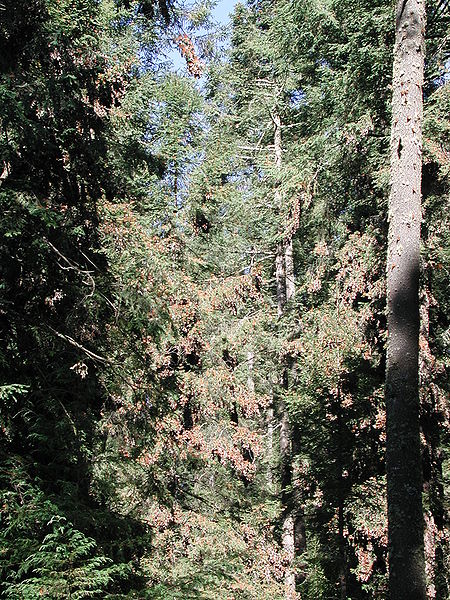
MONARCHS IN A TREE IN TEXAS
The wintering areas of the butterfly are located on the mountainous forests that stretch across far eastern Michoacán state and far western Mexico State, about 100 km northwest of Mexico City.[10][11] The area on the Michoacán side consists of the highest elevations of the state, including peaks that reach 2,700 masl. The climate of the region is classed as C(w2)(w)(b’(i"); or temperate and somewhat moist with a rainy season in the summer. Average maximum temperature is 22°C (71°F), with variance between 5 and 7°C. Altitude divides the region into three sub climates (cool and semi moist, semi cold and semi moist and cold and semi moist).[10]
The area is part of the Trans-Mexican Volcanic Belt and much of its terrain is due to outcroppings of basalt that formed fissures, faults and cliffs with a northeast-southwest orientation. These rock formations cover older ones such as volcanic cones and old lava beds. This area is highly permeable, so there is little surface water except for small ponds and arroyos.[10][15] These mountains are mostly covered in forests which vary by altitude and region: holm oak up to 2900masl, holm oak and pine between 1500 and 3000 masl and oyamel fir between 2400 and 3600masl. There are also small areas with junipers, cedars and meadows. Areas below 2400 have mostly been drastically modified due to agriculture and human settlements. The most important areas to the monarch are the forests of pine and oyamel fir trees as these areas provide microclimates that provide shelter when overall temperatures fall to freezing or when there are winter rains.[15]
The wildlife in the area ranges from the sub-tropical to the sub-arctic including a number of species that are endemic only to this area. These include white-tailed deer (Odocoileus virginianus), coyotes (Canis latrans), long-tailed weasels (Mustela frenata), grey foxes (Urocyon cinereoargenteus), rabbits (Sylvilagus spp.), crows (Corvus corax), turkey buzzards (Cathartes aura), horned owls (Bubo virginianus)(A), as well as various types of hummingbirds, reptiles and amphibians.[10]
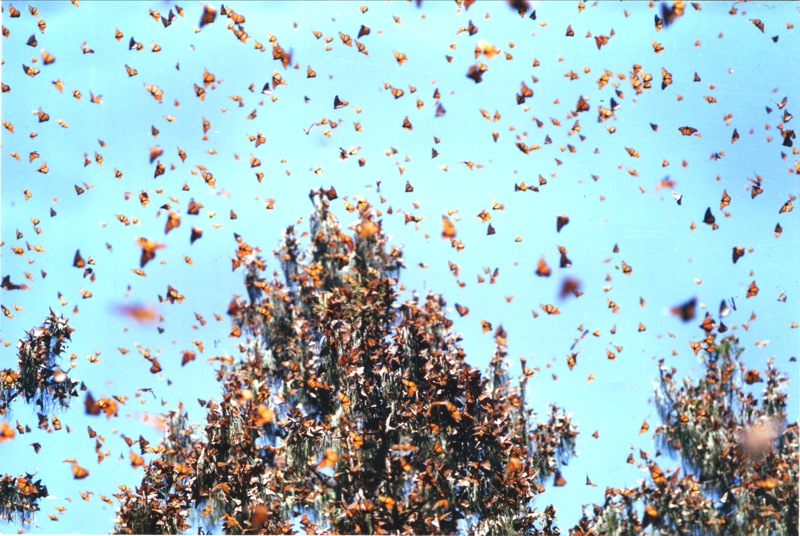 onarch
colonies
onarch
coloniesThere are fourteen major butterfly colonies located in these rugged forested mountains, which account for more than half of colonies of the monarch butterfly’s eastern U.S./Canada population. It is estimated that up to a billion individuals spend winter here in any given year.[9] These colonies are dense, with between six and sixty million butterflies per hectare.[12] The reserve areas are found in the municipalities of Ocampo, Angangueo, Zitácuaro and Contepec in Michoacán and Donato Guerra, Villa de Allende and Temascalcingo in the State of Mexico. They are divided into five principal zones or nuclei.[10]
Eight of the fourteen colonies are in the protected area.[9] The colonies proper cover only 4.7 hectares,[12] but the protected biosphere area covers 56,259 hectares.[9][11] Four colonies are open to visitors: Sierra Chincua and El Rosario in Michoacan, and La Mesa and El Capulin in the State of Mexico. There are other colonies near San José Villa de Allende and Ixtapan del Oro, but they are not actively promoted for tourism because of the risk of harm to these butterfly colonies.[16] El Rosario is the largest sanctuary in Michoacán, where the butterflies cover about 1,500 trees.[13]
While the Biosphere still has problems with infrastructure, most notably with trash (especially around parking and merchant areas), a number of improvements have been recently made, most notably in the sanctuary of El Rosario. These include well-defined footpaths with security patrols and stone/or concrete steps in steep places to help against erosion. Horsepaths were also eliminated for erosion reasons.[17] Only two areas have significant installations. In the Sierra Chincua there is a research facility dedicated to the monarch butterfly and a nursery for reforestation efforts. At Cerro El Companario there are facilities for tourism.[10]
Five of the eight colonies are located in Michoacán but only two are open to the public: Sierra Chincua in Angangueo and El Rosario in Ocampo. Both receive visitors starting from November until March. They offer guided tours.[8] In the State of Mexico, La Mesa and El Capulin are open to the public.[16] These reserves are visited by thousands of Mexican and international tourists, principally from the United States, Canada, Spain, France, Germany and Japan.[13] The best known and most visited of the butterfly colonies is El Rosario.[12]
In February, Anguangueo celebrates its Festival de la Mariposa Monarca (Monarch Butterfly Festival) .[18] This festival began in 1992 to promote awareness of the butterfly habitat, take advantage of the ecotourism it offers and promote the culture and arts of the area. The festival includes events related to food, music, dance and exhibitions of arts, crafts and more. Many of the surrounding communities participate including Aporo, Contepec, Hidalgo, Irimbo, Jungapeo, Maravatío, Ocampo, Senguio, Tuxpan, Tlalpujahua and Zitácuaro.[19] In 2010, the festival included the participation of the Symphonic Orchestra of Michoacan, The Enrico Caruso Ensemble, and the showing of an exhibition called "Papaloapan" about the monarchs by visual artist Luis Moro, as well as dance and photography workshops. These events took place at venues in Anguangeo and other nearby communities.[20]
The survival of the species depends on a large number of habitats from Canada, the United States and Mexico during its annual migration cycle. The three countries adopted a plan in 2008 for the conservation of the butterfly’s habitat through its migration routes.[6] Within the Biosphere in Mexico, the greatest threats to the butterfly habitat are deforestation, illegal logging, unorganized tourism, forest fires and lack of cooperation among various authorities.[10][15] Most of these dangers come from the surrounding human settlements, which put pressure on the natural areas to provide agricultural space and forestry products such as fuel and wood for manufacturing furniture and other crafts. The main human communities in the area are Contepec, Temascalcingo, Angangueo, Ocampo, San Felipe del Progreso, Zitácuaro, Villa de Allende and Donato Guerra. The closest urban center is Zitácuaro, whose growth has promoted the growth of the other, more rural settlements.[10]
In spite of this, most of the area is still occupied by dispersed rural farming communities of Otomi and Mazahua peoples, especially on the Mexico State side.[10][15] Many of the protected hectares do not belong to the government directly, rather they are lands divided among 59 ejidos, thirteen indigenous communities and 21 individual holdings. Because of this and the fact that the reserve is divided by a state line, conservation efforts are complicated. Many communities in this region are very poor, with high illiteracy rates and childhood malnutrition, with scarce access to basic services. In the past, mining provided much of the area’s jobs but mines have since been depleted and most live on subsistence agriculture. These communities also have a tradition of exploiting forest areas, mostly to obtain wood for furniture making and other crafts. High unemployment, especially for youth, also provoke migration out into other parts of Mexico and to the United States or Canada.[15]
Most of the butterfly colony areas still host economic activities such as subsistence farming and livestock raising. In some areas, such as Sierra Chincua, Cerro Pelon and El Rosario, there are still problems with illegal logging to supply local fuel needs as well as for raw materials for handicrafts.[10][13] El Rosario is named after the local ejido which belongs to about 10,000 “campesinos” or rural farmers. Many of these people make a living through farming and the sale of handcrafts and foods to tourists.[13] Information about the butterflies is insufficient as it is not know the full extent of their wintering areas, nor the ecology of the area. Because of this, it is not known how large the reserve really needs to be for the preservation of the butterfly.[10]
Conservation is mostly done through restrictions on the lands but the management of the reserve has not had direct participation by the communities affected by it.[10][15] Some public and private entities have worked with communities to develop incentives to conserve forests and take advantage of the tourism that the butterflies bring. However, success in this has been spotty.[15] Some communities are pushing back against the restrictions and demanding to be allowed to use more land for agriculture.[13]
Since conservation efforts began, there has been progress. While infrastructure is still lacking, advances have been made in areas such as trash control and control of access into the protected areas.[12] One effort by the World Wildlife Fund has been the coordination of international biologists and ecologists to improve the design of the reserve.[15] A permanent monitoring system has been established to ensure the forests remain healthy and control clandestine logging and forest fires. On the Mexico State side, the largest sanctuary is located between San José Villa de Allende and Ixtapan del Oro. It is not actively promoted for tourism to keep damage to the area to a minimum.(StateMex) During winter 2008-2009, there are plans to tag as many of the wintering butterflies as possible using very light self-stick tracers as to not impede their flight. The purpose of this is to determine the butterflies exact migration route as they fly back north to the U.S. and Canada in the spring.[17] Butterfly counts coming in from the United States and Canada in recent years were relatively stable in the 2000s, with a dozen confirmed colonies as of the 2007-2008 winter. Colonies number varies; in 2004/2005 there were only seven. In general, the number of colonies varies between eight and twelve.[12]
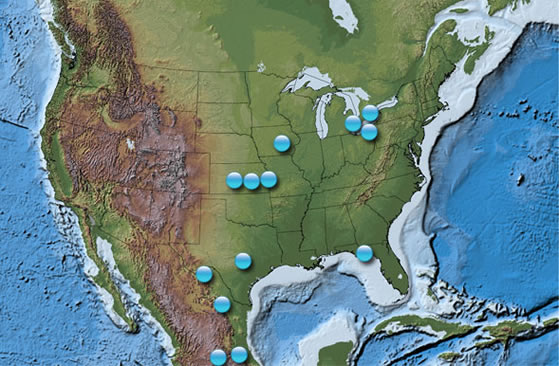
MONARCH CONSERVATORY REGIONS IN THE U.S.
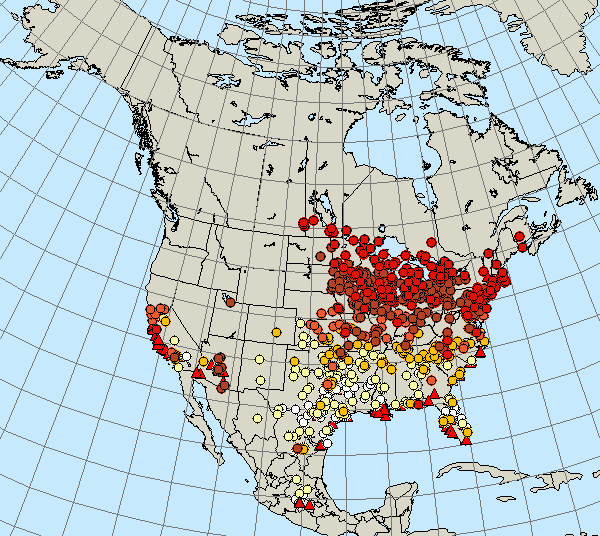
MONANRCH MAP WHERE MONARCHS ARE LOCATED IN THE U.S.
| Monarch Butterfly Update: May 17, 2012 |
|
||
| The migration has entered
three New England states and another Canadian province, and milkweed is
now growing across the monarch's breeding range. This week, explore
who's who in the milkweed community. Also, send us reviews of the
monarch books you recommend.
This Week's Update Includes:
|
frp," http://www.learner.org/jnorth/monarch/spring2012/update051712.html
another tracking site for you http://www.monarch-butterfly.com/
THIS BLOG CONTINUES ON PAGE 223
| 2011 INDEX |
|
INDEX - 2012 JAN - THRU APRIL |
|
INDEX 2012 MAY - THRU AUGUST |